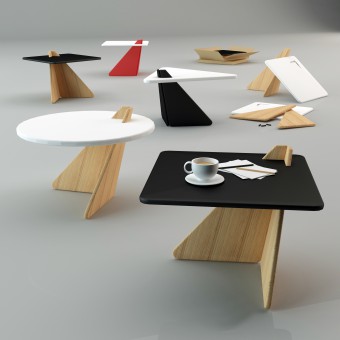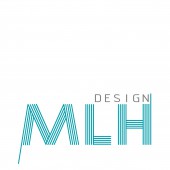Balance Coffee Table by Mehmet Lutfi Hidayetoglu |
Home > Winners > #53318 |
 |
|
||||
| DESIGN DETAILS | |||||
| DESIGN NAME: Balance PRIMARY FUNCTION: Coffee Table INSPIRATION: The design is inspired by tangram parts. Visually unstable design is structurally balanced. It uses an installation method that completely deactivates traditional furniture joining techniques, tools and installation expertise. Parts can easily be installed via the designs interlocking system. UNIQUE PROPERTIES / PROJECT DESCRIPTION: Balance, intended to emphasize asymmetric equilibrium, seems unstable at first sight and attracts the attention. Basically, it is no different from a furniture standing on three feet. Installation of the coffee table does not require expertise or tools and equipment such as nippers, screwdrivers, screws or minifix. It incorporates end users into the design process. Balance, having no stability problems, offers a minimalist, dynamic and a modern approach with its geometry and installation. OPERATION / FLOW / INTERACTION: The coffee table is basically no different than a furniture standing on three feet, and is installed by end user. In order to install the coffee table, which is 3-part-boards in total, first the feet are pinched via dowels and then plates are passed on to fasten up the table. There is no need for a tool, equipment or an installation expertise during the installation. PROJECT DURATION AND LOCATION: This design was projected in 2016 in Turkey. Design registration process continues. The prototypes were made in November of 2016 in Konya / Turkey. FITS BEST INTO CATEGORY: Furniture Design |
PRODUCTION / REALIZATION TECHNOLOGY: There are 3 main parts that make up the design. Those parts are processed through CNC woodworking machines. In order to get thin sections and for moisture resistance, Compact Laminate will primarily be used. At the same time, MDF (medium-density fibreboard) or solid boards can be used for low costs. With, recyclable boards, environmental solutions can be presented. SPECIFICATIONS / TECHNICAL PROPERTIES: The design will be packaged unassembled in a flat box. Dimensions of the box are approximately 50 x 50 x 5 cm. The weight is 2,5 kg, in accordance with international transport standards. Thanks to the layout in the box, there is no stacking limit. Accordingly; manufacturers and sellers do not have to reflect transport, storage or installation costs to users. TAGS: Table, Coffee Table, Furniture, Modular, Interior, Balance RESEARCH ABSTRACT: The aim of the project is to enable furniture to be assembled and disassembled many times, without using any tools by users, and to provide flexibility and personalization on the design. Manufacturer, on the other hand, tends to lower transportation, installation and service costs. That necessitates furniture to be delivered without assembly in small boxes, to be installed without expertise and its dynamic design features. Minifix, sockets, hinges, corner fittings and such assembly equipment that are used for furniture require expertise during installation. It is quite significant for designs to be planned in a way to knock installation expertise out. CHALLENGE: Main problem definition of the design is attractive, minimal approach and installation / transportation advantages. Flexible designs, however, make it necessary to be made of demounting pieces. But multipartiteness and detachability call for some important problems. The first is the deformation of parts during assembly or disassembly in a short time and the entailment that the installation must be conducted by an expert. This design has solved the problem with simple installation and interlocking techniques. ADDED DATE: 2017-02-09 19:35:34 TEAM MEMBERS (1) : IMAGE CREDITS: Image #1: Illustrator Mehmet Lutfi Hidayetoglu, Balance, 2017. Image #2: Illustrator Mehmet Lutfi Hidayetoglu, Balance, 2017. Image #3: Illustrator Mehmet Lutfi Hidayetoglu, Balance, 2017. Image #4: Illustrator Mehmet Lutfi Hidayetoglu, Balance, 2017. Image #5: Illustrator Mehmet Lutfi Hidayetoglu, Balance, 2017. PATENTS/COPYRIGHTS: Patent pending, Mehmet Lutfi Hidayetoglu, 2016. |
||||
| Visit the following page to learn more: http://hidayetoglu.wix.com/hidayetoglu | |||||
| AWARD DETAILS | |
 |
Balance Coffee Table by Mehmet Lutfi Hidayetoglu is Winner in Furniture Design Category, 2016 - 2017.· Read the interview with designer Mehmet Lutfi Hidayetoglu for design Balance here.· Press Members: Login or Register to request an exclusive interview with Mehmet Lutfi Hidayetoglu. · Click here to register inorder to view the profile and other works by Mehmet Lutfi Hidayetoglu. |
| SOCIAL |
| + Add to Likes / Favorites | Send to My Email | Comment | Testimonials | View Press-Release | Press Kit |
Did you like Mehmet Lutfi Hidayetoglu's Furniture Design?
You will most likely enjoy other award winning furniture design as well.
Click here to view more Award Winning Furniture Design.








